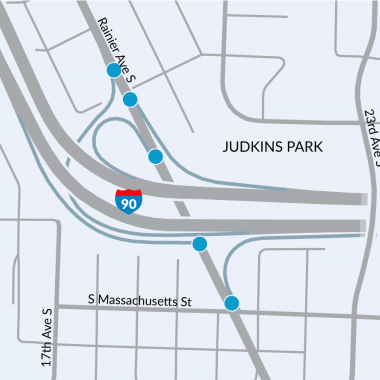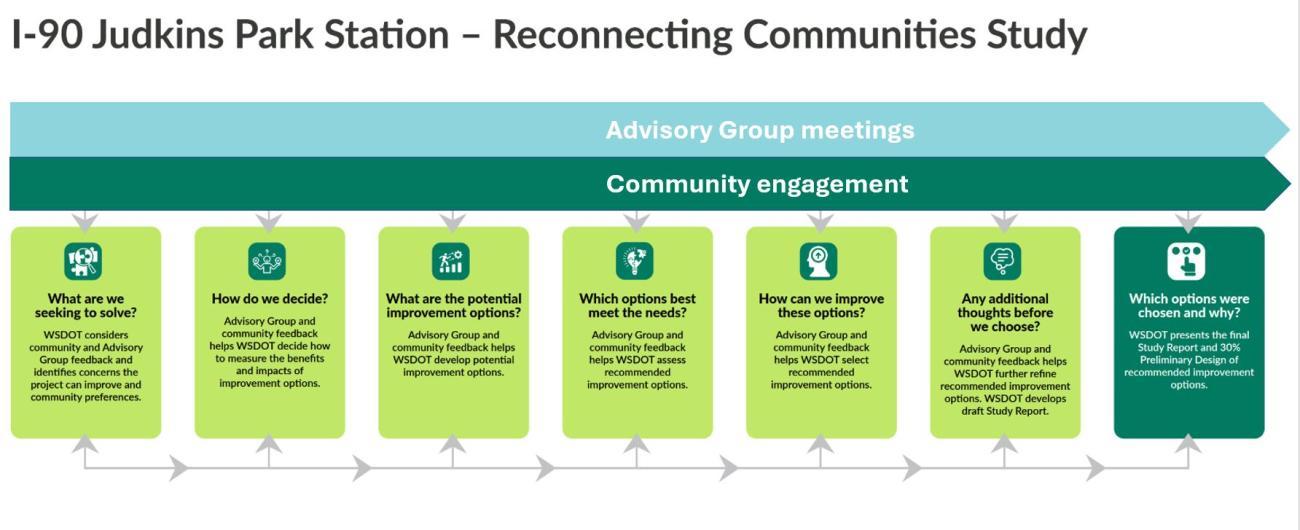Voters in 2008 approved a plan to extend the Link Light Rail to the east side of Lake Washington, placing a station in the middle of I-90, with one entrance near Judkins Park, and two entrances on Rainier Avenue South. However, those who walk, bike or use a mobility device accessing the station from Rainier Avenue South must cross on- and off-ramps that were not designed for a high volume of active transportation users.
This study continues the conversations started by the City of Seattle's Department of Transportation (SDOT) in their 2017 Judkins Park Station Access Study, and WSDOT's 2023 Removing Highway Barriers to High-Capacity Transit Station Access study, both of which engaged the community and resulted in recommendations to increase accessibility. King County Metro is planning for RapidRide R on the Rainier Avenue South corridor with a stop at the Judkins Park light rail station.
The study will focus developing solutions to increase connectivity and options which will provide many community benefits including:
Health benefits from increased walking and biking and reduced air pollution.
Economic benefits for businesses due to increased access to businesses via walking and biking and for the community due to cost savings of walking, bicycling, and using transit.
Social benefits from increased connectivity within the community and opportunities for community members including those without cars or with mobility challenges to connect.
Environmental benefits from decreased reliance on vehicles for travel and decreased urban heat from less traffic.
Equity and environmental justice benefits from improved connectivity and transportation options in overburdened communities.
Complete streets
WSDOT’s Complete Streets is an approach to planning, designing, building, operating, and maintaining streets that enables safe access for all people who need to use them, including pedestrians, bicyclists, motorists and transit riders of all ages and abilities. Creating Complete Streets enables safe and convenient access to destinations for all people.
WSDOT conducts robust community engagement on all Complete Streets projects, as these projects should be planned and designed to reflect the vision of the surrounding community.
Community engagement
Three listening sessions were conducted in late summer and early fall 2024 to hear about transportation challenges and needs and transportation preferences. These sessions included community-based organizations and other interested parties. A listening session summary will be posted soon.
A community survey from September 24 to October 29 sought feedback from community residents, businesses, organizations and other users that currently or in the future will travel on Rainier Avenue South at the I-90 interchange. A community survey report will be posted soon.
We will next seek out community feedback in an online open house and survey planned for early 2025.
Advisory Group
The Advisory Group consists of public works, engineering and planning staff from local entities, as well as community and community-based organization representatives. The Advisory Group serves in an advisory role to WSDOT, providing technical and community feedback at multiple steps in the study process.
Advisory Group Meeting 1
Thursday, December 12, 2024
Presentation (PDF 4.4MB)
Meeting recording
Environmental justice assessment
These actions are those that initiated after July 1, 2023, and consist of WSDOT transportation projects and grants of $15 million or more, new grant or loan programs, agency request legislation and rulemaking.
Environmental justice in Washington state, as provided in the HEAL Act, addresses disproportionate environmental and health impacts in all laws, rules, and policies by prioritizing vulnerable populations and overburdened communities, the equitable distribution of resources and benefits, and eliminating harm (RCW 70A.02.010).
Outcomes
Public input and community feedback, including input from listening sessions and interviews, online surveys, workshops, open houses, and other engagement with the community, will be vital to the study and the development of concepts.
Several concepts for bicycle and pedestrian facilities will be considered. Additionally, options for the I-90 ramps will be assessed to improve the safe travel for all modes. Each active transportation concept and ramp option will be evaluated using performance measures like the following:
How comfortable and safe it feels to walk or bike at the I-90 ramps.
How fast cars and other vehicles are traveling where ramps connect with Rainer Avenue South. Lower speeds usually mean safer conditions for everyone, especially pedestrians and cyclists.
How well the concept supports the goal of no traffic-related deaths or serious injuries.
How much time you spend near traffic like when you walk or bike across busy intersections. The more time spent near traffic, the higher the risk, so we aim to minimize this exposure.
How straightforward and easy it is to walk or bike to your destination. This means how easy it is for people walking or biking to get from one place to another without taking long detours or complicated routes. We want to create direct, easy-to-navigate paths for pedestrians and bicyclists.
WSDOT was awarded a $1 million federal RAISE grant and a $2 million State Sandy Williams Connecting Communities Program (SWCCP) grant for the I-90/Judkins Park Station – Reconnecting Communities Study. Design and construction are not currently funded.
The I-90 Judkins Park Station Reconnecting Communities Study process with 7 steps from identifying concerns the project can improve and community preferences to selecting the recommended improvement option.


